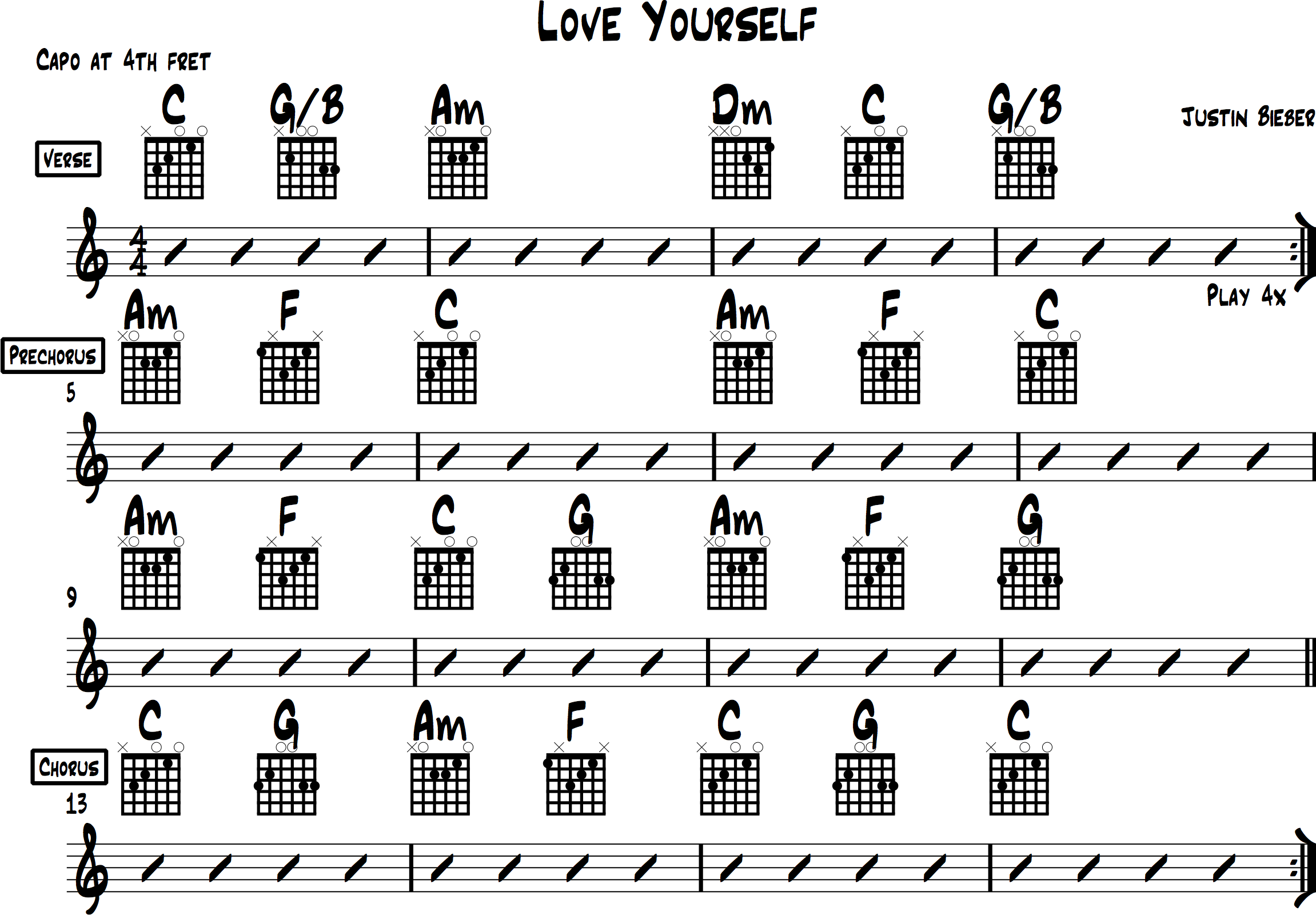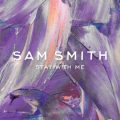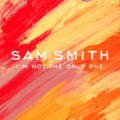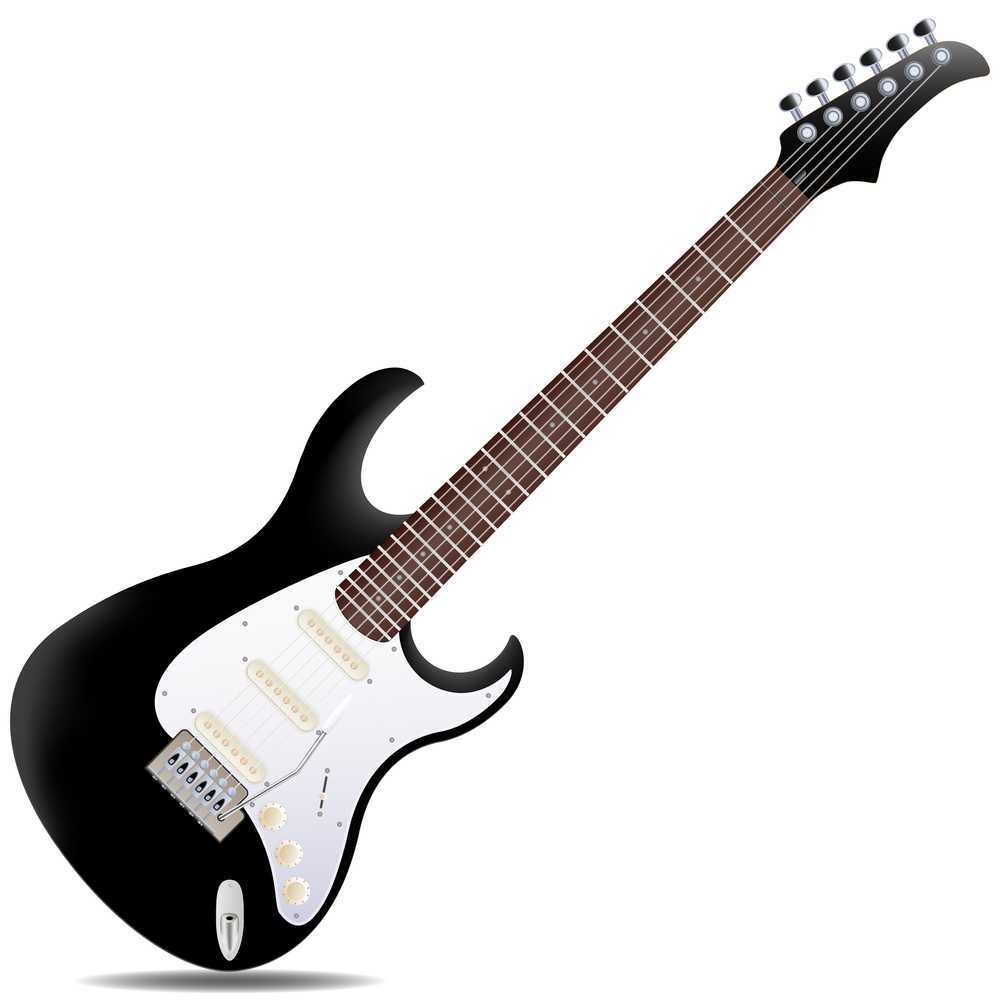 Justin Bieber’s fourth studio album, Purpose from 2015, launched the single Love Yourself. It was released first as a promotional single and later was released as the album’s third single. It was written by Ed Sheeran, Benny Blanco (a/k/a Benjamin Levin) and Bieber. Today we’ll learn an easy version of the Love Yourself chords.
Justin Bieber’s fourth studio album, Purpose from 2015, launched the single Love Yourself. It was released first as a promotional single and later was released as the album’s third single. It was written by Ed Sheeran, Benny Blanco (a/k/a Benjamin Levin) and Bieber. Today we’ll learn an easy version of the Love Yourself chords.
Bieber’s music is pop-based although he also adds elements of R&B. He has cited The Beatles, Boyz II Men, Mariah Carey, Michael Jackson, Justin Timberlake, and Usher as his musical influences.
Useful Links:
Song Specs
Title: Love Yourself
Artist: Justin Bieber
Songwriters: Justin Bieber / Benjamin Levin / Ed Sheeran
Album: Purpose
Key: C (with capo at the 4th fret)
Tempo: 100
Chord Progression: C–Dm–F–G–G/B–Am
Accompaniment Technique: First-Position Chords, Basic Fingerstyle with Percussive Strums
Playing Tips
Here are some helpful tips to keep in mind that will help you learn the tunes faster while giving you some ideas for how to approach performing it. I provided some useful links above and I’ll take you through the Love Yourself chords, accompaniment patterns, song form and a chord chart. Everything you need to get started playing this tune.
Love Yourself Chords
| Chords | C | Dm | F | G | Am |
| Progression | I | ii | IV | V | vi |

Love Yourself is a pop song that features an electric guitar and a brief flurry of trumpets as its main instrumentation. This is gonna force us to make some decisions as to how to approach this for an acoustic guitar.
The Love Yourself chords are all in the first position and shouldn’t create too much of a problem. The song is in the key of E but we’ll be using a capo at the 4th fret and thinking in the key of C. If we were to play in E, which is a guitar key, it would simply sound too dark.
We’re also gonna approach this from a finger-plucking and finger-strumming standpoint. I feel that using a pick would take away from the atmosphere that we’re trying to create. However, I do encourage you to approach the song however you see fit. These are just my suggestions.
Accompaniment Techniques
I’ve broken down my approach to this tune into three basic techniques that follow the song form. I use a fingerstyle technique that I’ll describe below. But, the basic idea is that my thumb plays the bass note (as the left hand of the piano would) and my index, middle, and ring fingers pluck or brush the top part of the chord (as the right hand of the piano would).
The song is made up of three parts: verse, pre-chorus, and chorus. Here’s the basic techniques that I aim for.
- Verse: Finger-plucking with a staccato rhythm that reflects the way that Bieber approaches the song as well.
- Pre-chorus: Finger-plucking, but this time with a more rhythmic feel. We want to create motion while changing the texture.
- Chorus: Finger-strumming as this is the climax of the song.
Basic Fingerstyle Technique
“Love Yourself” is perfect for beginning fingerstyle players. The right hand is notated as follows:
- P = Thumb
- I = Index
- M = Middle
- A = Ring
As I mentioned earlier, I find that using a pick to strum the Love Yourself chords can be a little too harsh sounding for the mood of this tune. For that reason, I suggest using your fingers to pluck and strum the chords. Let’s begin by assigning the right-hand fingers to certain strings:
- The Thumb (P) plays the bass note:
- 6th string for G and F
- 5th string for C, G/B, and Am
- 4th string for Dm
- The Index (I) is assigned to the 4th string.
- The Middle (M) is assigned to the 3rd string.
- The Ring (A) is assigned to the 2nd string.
- The I-M-A fingers move up a string set for the Dm chord. Or, you could assign the I-M-A fingers to the 3rd, 2nd and 1st strings right from the beginning.
This is the essence of fingerstyle playing, assigning fingers to specific strings. This way, you don’t need to look at the right hand while playing. Once you get used to it, you can “feel” where you are. I suggest using the finger-plucking technique for the verse and pre-chorus and the finger-strumming technique for the chorus. I explain this in more detail in the video.
Percussive Strum
This technique is subtle but adds to the groove and feel of the tune. Here’s how to execute it:
- Use the same finger assignments as described above.
- Finger-pluck the chord on Beat 1.
- On Beat 2, bring the fingers back to their assigned strings creating a muted strum.
- Finger-pluck the next chord on the “and of Beat 2”.
- On Beat 4, bring the fingers back to their assigned strings creating a muted strum.
Chord Chart
I’ve included a Love Yourself chords chart, which is a simple road map that shows you:
- The overall arrangement of the song.
- A section by section breakdown of the song.
- Each chord and how long to play it for.
If you don’t read music, please don’t be intimidated. This is a cheat sheet that can help you get through the tune quickly and easily. I find it indispensable for learning songs and I can also hand it to a seasoned musician and they can follow along without any problems.
Song Form
- Verse: 16-bar section; A 4-measure pattern that repeats four times. The pattern is made up of two chord riffs each of them are two bars in length.
- Chord Riff 1; C–G/B–Am, C for two beats, G/B for two beats and Am for a full measure.
- Chord Riff 2; Dm–C–G/B, Dm for two beats, C for two beats and G/B for a full measure.
- Prechorus: 8-bar section; Bar 1, Am for two beats and F for two beats; Bar 2, C for a full measure; Bar 3, Am for two beats and F for two beats; Bar 4, C for a full measure; Bar 5, Am for two beats and F for two beats; Bar 6, C for two beats and G for two beats; Bar 7, Am for two beats and F for two beats; Bar 8, G for a full measure.
- Chorus: 8-bar section; A 4-measure progression that repeats. Bar 1, C for two beats and G for two beats; Bar 2, Am for two beats and F for two beats; Bar 3, C for two beats and G for two beats; Bar 4, C for a full measure.
Once you become familiar with chord charts, you’ll never want to go back. It’s just easier to see where you’re going when you have a map. And, it’s especially helpful when you’re not familiar with the song or there’s a section of the song that you don’t remember (Bridges and Interludes are notorious for surprising players and derailing a song’s performance). Fortunately for us, this tune doesn’t have either.

Wrap-up
I hope that you’ve enjoyed learning Love Yourself and if you haven’t checked out any Beatles, Boys II Men or Mariah Carey then I encourage you to do so. It’s nice to see where today’s artists get their inspiration from and you may discover a new world of music that may motivate you to explore a new direction.
I appreciate you checking out this lesson on the Love Yourself chords. Thanks for hangin’ with me and I’ll see you next time.







